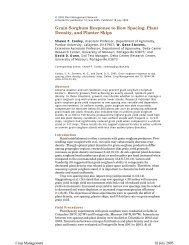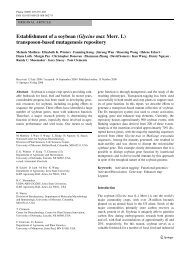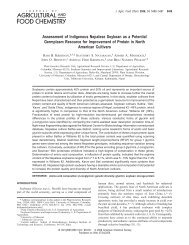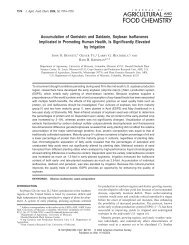Development of marker-free transgenic sorghum ... - Plant Sciences
Development of marker-free transgenic sorghum ... - Plant Sciences
Development of marker-free transgenic sorghum ... - Plant Sciences
Create successful ePaper yourself
Turn your PDF publications into a flip-book with our unique Google optimized e-Paper software.
<strong>Plant</strong> Cell Tiss Organ Cult (2009) 99:97–108 103Table 3 Transformation with pZY101-TC2ExperimentcodeNumber <strong>of</strong>embryosinoculated(NE)Number <strong>of</strong>independentcallus lines (NC)Frequency <strong>of</strong>independent calluslines (NC/NE) (%)Number <strong>of</strong> independent calluslines regenerating at least oneshoot (NS)Number <strong>of</strong>independent eventsin greenhouse (NP)Transformationefficiency (NP/NE) (%)L22 241 2 0.8 1 1 0.4L23 687 20 2.9 3 3 0.4L73 250 6 2.4 1 1 0.4L77 176 11 6.3 2 1 0.6Total 1,354 39 2.9 7 6 0.4Table 4 Transformation with pZY101-SKRSExperimentcodeNumber <strong>of</strong>embryosinoculatedNumber <strong>of</strong>independent calluslines (NC)Frequency <strong>of</strong> independentcallus lines (NC/NE) (%)Number <strong>of</strong>independentshoots (NS)Number <strong>of</strong>independent plantlines (NP)Transformationfrequency (NP/NE)(%)L25 403 11 2.7 4 2 0.5L31 308 13 4.2 5 4 1.3L36 351 3 0.9 2 1 0.3L41 1,133 8 0.7 2 2 0.2L42 774 6 0.8 2 1 0.1L49 560 10 1.8 1 1 0.2L50 543 10 1.8 3 2 0.4L51 490 5 1.0 1 1 0.2L57 355 2 0.6 2 1 0.3L58 231 1 0.4 1 1 0.4L61 1,166 78 6.7 45 39 3.3L62 1,103 2 0.2 2 2 0.2L63 423 2 0.5 1 1 0.2L73 327 6 1.8 1 1 0.3L74 245 6 2.4 1 1 0.4L75 403 19 4.7 3 3 0.7L77 172 16 9.3 5 4 2.3L79 140 2 1.4 2 1 0.7L81 280 15 5.4 4 4 1.4L82 284 9 3.2 1 1 0.4L84 266 12 4.5 1 1 0.4Total 9,957 236 2.4 89 74 0.7containing pZY102 displayed blue or dark blue color, butcontrol (calli developed from embryos which were treatedwith IM only instead <strong>of</strong> A. tumefaciens suspension andthen transferred onto CM without PPT) did not displayGUS staining. Leaf painting results exhibited that allplants <strong>of</strong> 80 putative <strong>transgenic</strong> events were resistant toLibertyÒ. The painted areas <strong>of</strong> the putative <strong>transgenic</strong>plants faded slightly or without any symptom, butnecrosis occurred with all non-<strong>transgenic</strong> controls (Fig. 2hand i).Molecular analysis <strong>of</strong> T0 <strong>transgenic</strong> plantsAll <strong>of</strong> the regenerated T0 plants were transplanted to thegreenhouse for seed maturation. The presence <strong>of</strong> bar andtRNA lys or SKRS genes in the <strong>transgenic</strong> plants was confirmedby PCR with specific primers. For plants transformedwith pZY101-SKRS, initial PCR screening <strong>of</strong> thebar gene was carried out with primer pair 1, and thenpositive samples were further screened with other twoprimer pairs to confirm the integrity <strong>of</strong> SKRS gene.123








